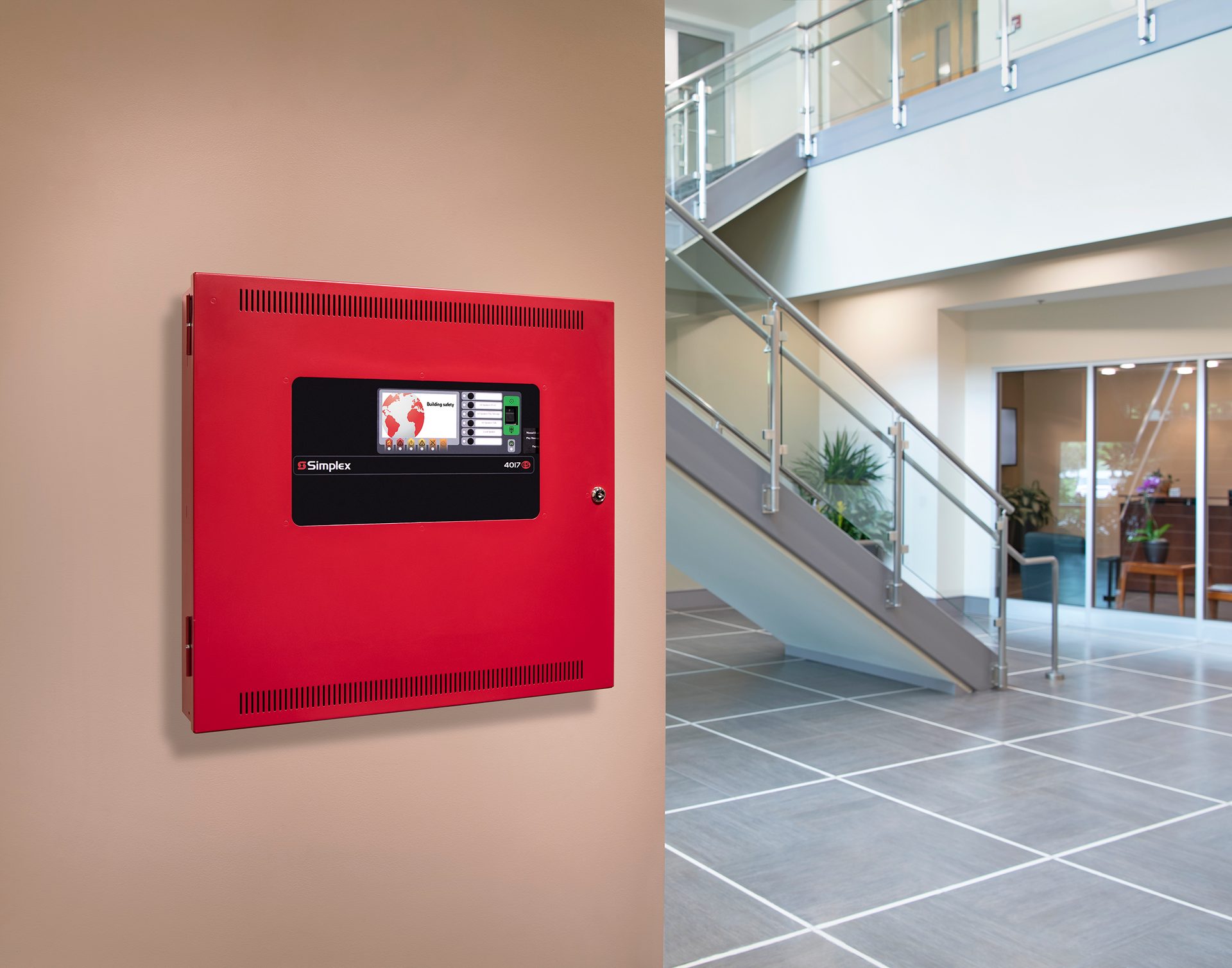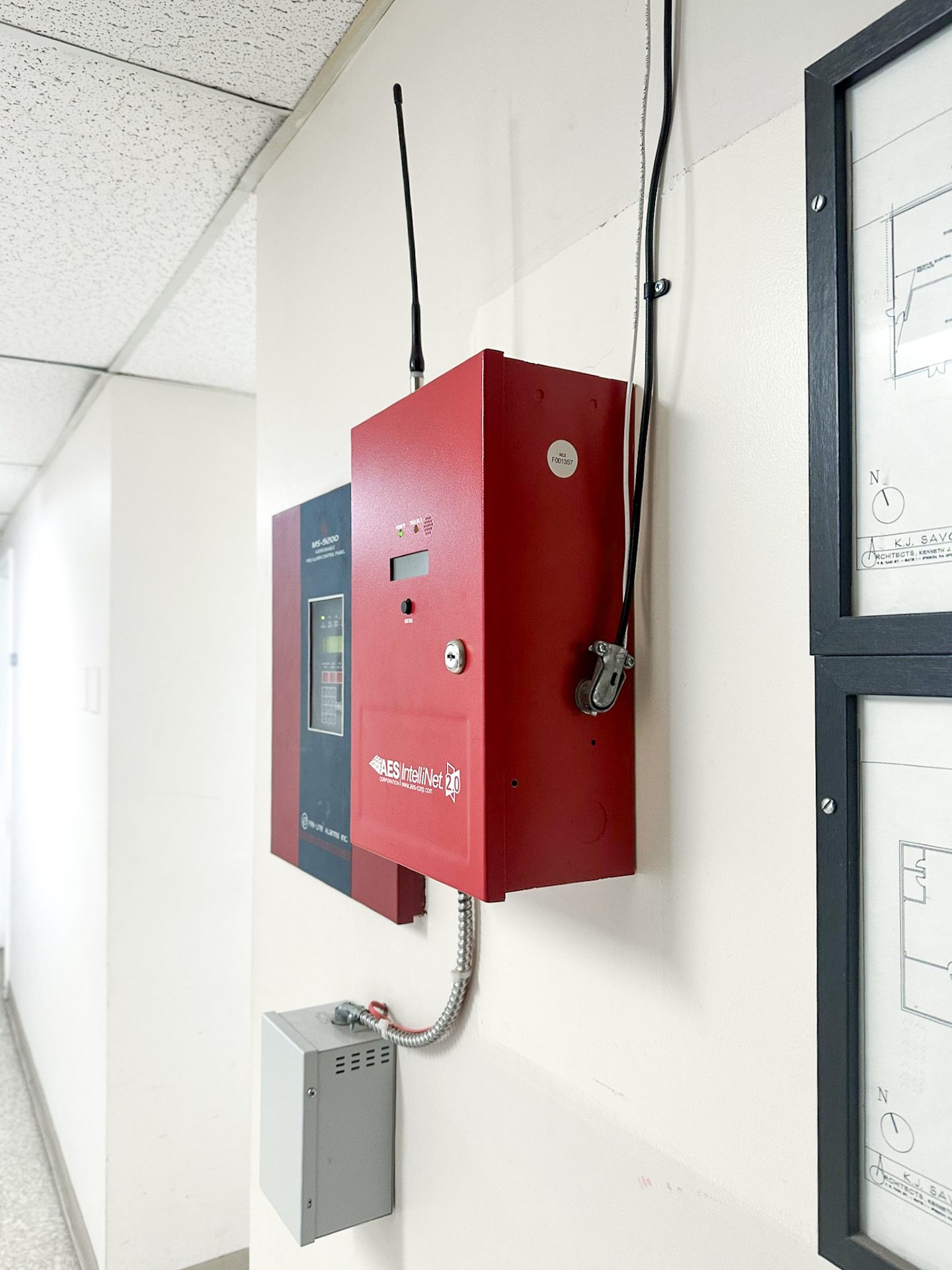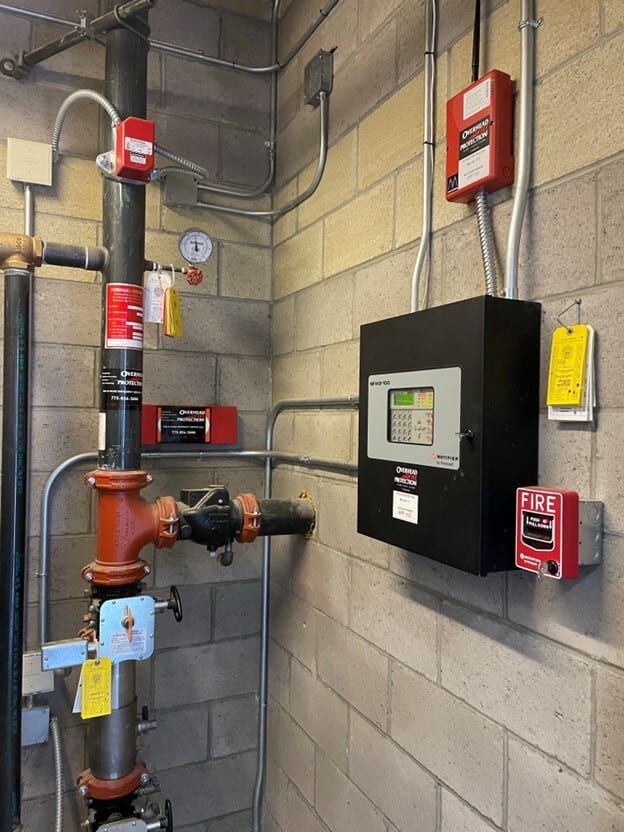october 2025
// SDM EXCLUSIVE

Sponsored by:
State of the Market:
Fire & Life Safety Advances
Industry experts note exciting trends in both customer demand and technology advancements in the fire alarm space.
By Karyn Hodgson, SDM Editor

The fire alarm industry saw steady growth in 2024, driven largely by a wave of new infrastructure projects, particularly in the energy and industrial sectors, which demand comprehensive fire detection solutions. Image courtesy of Johnson Controls

SHARE
By any measure, the market for fire, life safety, and emergency systems in 2024 and 2025 remained strong, even amidst some political and economic uncertainties. The fire and life safety market, like the security industry overall, is often described as “recession-resistant” — with the added advantage of being required by code.
This is one of the things that makes it an attractive niche for many security dealers and integrators. But, for the same reason, fire-related technology has sometimes tended to lag behind the greater security industry when it comes to adopting the latest cutting-edge solutions. Now, that is beginning to change, and manufacturers, systems integrators, and code-making bodies are all taking notice.
“2024 was a record-breaking year for ORR Protection and a strong year for the fire alarm industry overall,” says Rick Reynolds, executive vice president, business development for the Louisville, Ky.-based integrator, specializing in fire. “Demand grew across mission-critical environments as organizations prioritized compliance, resiliency, and uptime protection. For ORR, revenue and net income reached all-time highs, driven by significant growth in sectors like data centers, power generation, connected communications, modular construction, and battery energy storage systems. Compared to 2023, we saw measurable increases in both new project volume and recurring revenue tied to service and monitoring.”
Reynolds also points to growth in AI infrastructure impacting fire and anticipates continued double-digit growth up to 25% for 2025 over 2024, supported by a “strong backlog and healthy pipeline across all regions.”
Alpharetta, Ga.-based Pye-Barker Fire & Safety, ranked No. 4 on the 2025 SDM 100, had similar experiences, according to Boyd Ferrin, national sales leader. “I have taken a small sampling of some of our companies in other areas, and we all believe that 2024 was stronger than 2023,” he says. “There are a couple of reasons for that. One was a carryover from 2023, and we were able to land some good projects in 2024.”
While the political climate did hinder business somewhat as companies were uncertain how things would play out in 2024, Ferrin says that tentativeness opened up post-election. “Fire is code-driven and necessary, so it is somewhat resilient to political issues,” he says. “2025 started out a bit sluggish, and part of that was the political changes and government monies and uncertainty. But that has calmed down.”
Darrell Sackwar, director of fire alarm and life safety business development, Convergint, Schaumburg, Ill., partly attributes pent-up demand from the post-COVID chip shortages to his company’s double-digit growth in 2024; but, he adds that growth is normal for the company. “For Convergint specifically, we really doubled down our efforts in fire,” he says. “We have a national support team, and we do a lot of education and information sharing across Convergint. … Having more and more Convergint offices getting into fire gives us a bigger footprint. It took us from a group of offices that offered fire to much more of a national presence, which changed the game.”
Gregory R. Breyer, vice president, design and compliance, Zeus Fire and Security, Paoli, Pa., has a similar tale. “The fire alarm industry remained strong throughout 2024, with continued growth across inspection and testing, service, and installation,” he says. “We saw a notable expansion within our fire alarm pillar, driven by both increased market demand and our commitment to elevating team capabilities.”
On the vendor side, the fire market was equally strong, notes Tom Karl, vice president, corporate sales, NAPCO Security Technologies Inc., Amityville, N.Y. “2024 was a banner year for NAPCO, as our national account partners continued to improve the reliability and safety of their subscribers by replacing copper POTS lines connected to their fire alarms with cellular multi-carrier fire communicators,” he says. “This not only increases reliability over copper communications, but it also offers substantial savings to the subscriber, while at the same time increasing the fire contractors’ RMR.”
“The fire alarm industry remained strong throughout 2024, with continued growth across inspection and testing, service, and installation. We saw a notable expansion within our fire alarm pillar, driven by both increased market demand and our commitment to elevating team capabilities.”
— Gregory R. Breyer, Zeus Fire and Security
Those respondents characterizing the fire alarm/emergency communications market as excellent or very good rose 5 percentage points in 2025 (reporting on their 2024 numbers) over the previous year.
The Cyber Side of Fire
The more connected — and interconnected — fire alarm systems get, particularly as they move into remote services and cloud environments, the more important it is to stay up to date with cybersecurity requirements. This is something NFPA recognized starting in the 2022 edition of NFPA 72, and it has only grown in relevance since then, says Gregory Breyer of Zeus Fire and Security.
“It has become a critical consideration for system design, installation, and maintenance,” Breyer says. “As fire and life safety systems become more interconnected, protecting them from cyber threats is essential.”
NAPCO’s Tom Karl agrees. “With today’s evolving threats — deepfakes, AI-generated malware, and increasing cloud vulnerability — dealers must take greater precautions in choosing manufacturers,” he says. “NAPCO’s SOC 2-certified Network Operations Center (NOC) meets the highest standards for data protection.”
As more customers seek to share information to and from panels and use AI tools and automation, integrators need to be careful when choosing solutions for their customers, Karl adds. “While large organizations, in particular banks and financial institutions, now routinely require SOC2 compliance, it’s an important safeguard for all dealers to look for in their manufacturer partners,” he says.
Telguard, Atlanta, also references the sunset of “plain old telephone service,” or POTS, as being integral to their business success. “Telguard had another excellent year in the commercial fire alarm industry with our focus on cellular and dual path commercial fire communicators,” says George Brody, the company’s president. “Consistent increases in replacing POTS communicators for cellular technology … as well as builds, upgrades, and retrofits in key vertical markets contributed to continued growth.”
Rodger Reiswig, vice president of industry relations, Johnson Controls, Milwaukee, observes, “The fire alarm industry saw steady growth in 2024, driven largely by a wave of new infrastructure projects, particularly in the energy and industrial sectors, which demand comprehensive fire detection solutions. This trend reflects market projections that the fire detection and suppression sector will grow at a 3.5% compound annual rate (according to Grand View Research). We’re experiencing this growth in real time. … As infrastructure investment accelerates, we’re seeing that contractors and building owners are prioritizing user-friendly, high-quality systems that meet evolving local, state, and federal fire code and safety compliance requirements.”
Grand View Research estimates the 2024 North American Fire Market revenue at $30.3 billion and forecasts an increase to $37.4 billion by 2030. Another research firm, Markets and Markets, tracks the global fire market, estimating it to be around $75.1 billion in 2025, with the North American market accounting for the largest share.
SDM’s own research, the 2025 Industry Forecast, also reflects growth in 2024, with those characterizing the fire alarm/emergency communications market in 2024 as “very good to excellent,” rising 5 percentage points over the previous year to nearly 50%. Even better, 51% predicted an increase in fire-related revenue in 2025.
But these numbers only tell part of the story. Ahead, SDM looks more in-depth at the market trends driving the fire alarm industry, new technologies and their impact on business, as well as the top opportunities — and challenges — for dealers and integrators.
Market Trends & Drivers
While no one is suggesting that fire alarm systems are not still a code-driven purchase decision, there are some impactful changes in customer expectations for this have-to purchase, along with some voluntary upgrades in the mix. There are also some fast-growing verticals with an extensive need for complex fire and life safety systems.
“Everyone knows fire alarm systems are required by code, but we are also seeing some optional systems for high-value facilities because they are so critical,” Sackwar says. “The data center explosion has systems going in that are in excess of code because of what is being protected.”
Sackwar also notes that in some cases insurance providers are requiring more than just code. One example of this is automated warehousing. “Those machines are extremely expensive, and loss of production would be tremendous, so we are seeing insurance companies requiring pretty sophisticated systems,” he explains.
“In 2024, we saw a clear shift in customer priorities, with increased demand for integrated fire and video solutions at outdoor energy sites, as well as growing interest in monitoring platforms that offer data analytics and compliance tracking,” says Lee Kaiser, vice president, engineering and training, ORR Protection. “Additionally, more clients, particularly those with hybrid or modular infrastructure, are seeking flexible service models that align with their evolving operational needs.”
Another important factor is increasing attention to — and enforcement of — compliance issues.
“The fire alarm industry is inherently code-driven, and, in recent years, we’ve seen heightened attention to compliance,” Breyer says. “This trend not only strengthens public safety but also creates more opportunities for Zeus to fulfill our mission of protecting people, property, and business profitability.”
Breyer points to the most recent editions of the International Building Code (2024) and NFPA 72 National Fire Alarm and Signaling Code (2025) as being particularly influential in the evolving requirements for professional certification and licensing and raising industry standards.
The sunsetting of POTS has created an opportunity for other types of communications technologies, from cellular to mesh networks like AES. Image courtesy of AES

One advancement helping propel the fire market forward has been the advent of multi-carrier cellular options for communicating between the fire panel and central station. Image courtesy of Telguard

Those expecting an increase in revenue this year rose 8 percentage points compared to the previous year. Just 4 percent expect their fire-related revenues to decrease this year.
“High upfront costs and the complexity of retrofitting older buildings have slowed adoption — particularly among smaller businesses and budget-constrained organizations. That said, fire protection remains a compliance-driven, mission critical need. These structural tailwinds are expected to outweigh the headwinds, supporting continued industry resilience and expansion.”
— James Guzikowski, ADI | Snap One
Code Update
When it comes to fire alarm code-making bodies, one of the biggest ones to pay attention to is NFPA 72, the National Fire Alarm and Signaling Code. This code is updated every three years, with the most recent edition being 2025. However, not all states and municipalities follow the same version, with many Authorities Having Jurisdiction (AHJs) lagging one or two editions — and in some cases even more — behind the “current” edition.
Still, when it comes to new projects and staying up to code, the most recent edition is always the best starting point, with the caveat that you need to check with your local AHJ to be sure they will accept any suggested changes. So, what are some of the latest changes to NFPA 72?
According to NFPA, the latest edition covers the application, installation, location, performance, inspection, testing, and maintenance of fire alarm systems, supervising station alarm systems, public emergency alarm reporting systems, fire and carbon monoxide detection and warning equipment, and emergency communications systems and their components.
The major change to NFPA 72 in 2025 was a new chapter on cybersecurity; new requirements for acoustic leak detectors and thermal image fire detectors; requirements for smoke detectors on high ceilings; a new notification mode for use in spaces with populations sensitive to sudden, loud sounds; a detailed voltage drop calculation method; and new requirements for auxiliary service providers.
“This past year, we saw an update from NFPA 72 take effect,” says Rodger Reiswig of Johnson Controls. “With technology in fire and life safety evolving at a rapid pace, keeping up with the latest NFPA codes and standards is critical for protecting people and property and delivering uninterrupted service across all types of facilities. Professionals across the board have picked up the pace throughout the year in bringing their systems up to code and evaluating areas for improvement to make sure they’re ready for the next revision cycle in 2028.”
The first draft meetings for the 2028 edition of NFPA 72 began in July, with the second draft meeting due to be held in July 2026. A draft will be written at the technical meeting in June 2027, with an expected publication date later in 2027.
James Guzikowski, senior category strategist, ADI | Snap One, Melville, N.Y., says that stricter code enforcements — fueled in part by ongoing government mandates and increased funding for public safety upgrades, urban development, and new construction — are reshaping market expectations. “These trends are not only driving adoptions today but are poised to continue shaping the industry’s evolution in the years ahead,” he says.
Reiswig agrees. “Evolving fire codes are raising the bar for compliance,” he says. “New and updated regulations are requiring detection platforms to harden systems against cyber-attacks, deliver more advanced detection and alert capabilities, and communicate emergency information to fire professionals with minimal delay. These requirements are increasing end-user demand for code-aligned, future-proof fire alert systems while also challenging manufacturers to meet higher technical and security standards without slowing time to market.”
Another historical influential market driver — and potential hinderer — is the general economy. For the past several years, there have been fears of a looming recession that never materialized. And, starting in 2025, on-again/off-again tariffs have created a new level of worry.
“Market uncertainty and interest rates are suppressing some construction efforts, but we are still seeing a lot of upgrades,” Sackwar notes. “There are a lot of outdated systems in the fire market. Change in occupancy and repurposing of buildings changes their requirements for fire systems, so we continue to see growth. Even in years past when the economy slowed, we still saw a lot of repairs and upgrades.”
That said, interest rates have created more hesitancy to invest in new builds, Sackwar adds, but it isn’t hurting business. “That is a slight hindrance,” he says. “For us, there is so much market share and business out there, and we continue to get better and better every year with internal efficiencies; I don’t see it slowing us down at all.”
That seems to be the general opinion of most experts interviewed for this article.
“While we are cautious of the macroeconomic challenges and the impacts of tariffs in 2025, both the industry and our organization have demonstrated resilience and strong performance,” Breyer says. “Despite these external pressures and impacts on the business, overall market demand for our services has stayed robust. Looking ahead, the company is forecasting sustained growth during the second half of FY25 and remains on track to achieve our performance targets for the year.”
As a distributor, ADI | Snap One hears from a wide swath of dealers and integrators. Guzikowski is optimistic, based on that feedback: “Certain challenges have tempered growth. High upfront costs and the complexity of retrofitting older buildings have slowed adoption — particularly among smaller businesses and budget-constrained organizations. That said, fire protection remains a compliance-driven, mission critical need. These structural tailwinds are expected to outweigh the headwinds, supporting continued industry resilience and expansion.”
The Impact of New Technologies
While it may be more conservative when it comes to adoption, the fire alarm market is no stranger to the new and exciting technology advancements that are heavily influencing the greater security industry — particularly artificial intelligence, cloud computing, and integration.
“End users are increasingly seeking fire alarm technologies that deliver greater intelligence, situational awareness, and operational efficiency,” says ORR Protection’s Kaiser. “Products that integrate video with fire detection are in high demand, as customers want more visual data about what’s happening during an alarm event, especially in high-risk or remote environments. They also want smart sensors that can monitor critical equipment and provide dual functionality, serving both as environmental monitors and fire detectors. Mobile monitoring capabilities are another key expectation, allowing users to receive system alerts and diagnostics directly on their personal devices, wherever they are. … These trends, along with growing interest in AI-based analytics, ERCES systems and cloud-connected platforms, are shaping the next phase of growth for the fire alarm industry.”
Emergency Responder Communication Enhancement Systems (ERCES) have been particularly influential in recent years. Required in certain instances by code, these systems assist first responders in being able to communicate while inside a building during an emergency response.
“In my view, ERCES represent the most significant opportunity for growth in the fire alarm industry,” says Zeus’s Breyer. “While emergency responder radio coverage compliance has been included in base building codes since 2015, widespread adoption and enforcement have taken several years to materialize. This life safety system addresses a long-standing challenge: emergency responders historically struggled to communicate effectively within newly constructed buildings. Inadequate radio coverage not only put first responders at risk but also hindered the ability of police, fire, and EMS personnel to protect the public.
“Today we are seeing a shift in perspective,” Breyer continues. “Where some jurisdictions were previously hesitant to enforce ERCES requirements, there is now a strong focus on the meaningful life safety improvements these systems provide. The increased adoption of ERCES is not only critical for protecting people and property, but also represents a substantial growth opportunity for the industry.”
Pye-Barker’s Ferrin also sees ERCES technology as a growing opportunity. “ERCES has been great technology where we can boost radio signals and help first responders,” he says. “[But] I think the biggest technology change in the last three to five years is the networking available between campuses. There is now the ability to put things in the cloud. I could sit at my desk and look at three campuses and know what is going on.”
Convergint’s Sackwar agrees. “Fire systems in general have become more sophisticated,” he says. “The fire panel is really more of a microprocessor computer taking in information from devices. Because many now include voice, the fire system is part of the building’s integrated life safety and security plan for things other than fire, such as weather or security.”
Other technologies becoming more prolific are systems that can report their health status to the cloud, helping integrators get the right parts on trucks before rolling to a site. But going beyond just reporting will take longer to happen with fire systems — if ever, Sackwar adds.
“You can look at a lot of things remotely now, but you can’t do a lot of things remotely,” he says. “I see that being very slow in coming. Any program changes have to be tested, and you have to have somebody on site to verify that it works. The risk is so great, if a programming sequence were changed, it might stop the system from doing its job. The fear of that is greater than the efficiency of doing it remotely.”
One area where Sackwar and others do see increasing efficiency happening in the fire alarm space is in the rise of AI. From being able to learn on the spot which local codes apply, to predicting maintenance needs and helping reduce false alarms, AI is only beginning to demonstrate its value.
A majority of companies (60%) currently offer/sell/install fire alarm products. Of those not currently offering fire alarm products and services, 19 percent are considering starting to offer them within five years.

$30.3 billion
The size of the North American fire protection system market in 2024. Source: Grand View Research
Image courtesy / da-kuk / E+ / Via Getty Images
“Fire systems in general have become more sophisticated. The fire panel is really more of a microprocessor computer taking in information from devices. Because many now include voice, the fire system is part of the building’s integrated life safety and security plan for things other than fire, such as weather or security.”
— Darrell Sackwar, Convergint
“Over the past year, market growth has been fueled by surging demand for smarter, digitally connected fire detection solutions,” says Johnson Controls’ Reiswig. “IoT and AI are reshaping the sector with modern fire monitoring systems now gathering and analyzing data, integrating with mobile platforms and providing real-time safety information from virtually anywhere. Many can automatically alert fire professionals the moment an incident is detected. This has opened the door for manufacturers to expand their portfolios with innovative, AI-ready products that meet the needs of a more connected future.”
This trend is motivating customers to upgrade, perhaps more quickly than in the past, says Guzikowski of ADI | Snap One. “The industry’s shift toward IoT and AI-enhanced detection systems is also accelerating upgrade cycles, offering compelling value where retrofits may not have previously been justified,” he says.
Another technology trend Reiswig sees shaping the market is the move from away from POTS. “The transition to IP- and cellular-based communicators, integrated with cloud platforms and mobile apps, is enabling remote diagnostics, real-time alerts, and new recurring revenue opportunities,” he says.
One advancement helping this transition along has been the advent of multi-carrier cellular options, says Daniel Rosales, senior director of technical service, PLM, and marketing, Telguard. “The notion of having a single device that can use any of the major carriers in the U.S. depending on who performs best is a concept the industry has really welcomed with open arms,” he says. “As we continue to produce quality products with innovative technology that gets rid of the single-carrier headaches, we will continue to see the growth of cellular adoption.”
NAPCO’s Karl adds: “Advances in communications technology have greatly increased the reliability and integrity of fire alarm communications. Cellular fire alarm communicators that support multiple carriers not only ensure there will be an active carrier at all sites, but also provide an additional level of redundancy. If, for any reason, the primary carrier is not available, the communicator can quickly switch to the secondary carrier to ensure that the life-safety signal is delivered.”
Future Opportunities & Challenges
Whether from communications technology, cloud, or AI, more integrators are seeing recurring revenue opportunities in the fire space beyond the traditional test/inspection.
“The need for transmitting more data from fire panels continues to evolve and impact the fire market,” says Laura Wall, vice president of product management, AES, a mesh network provider based in Peabody, Mass. “Also, the shift to an RMR model continues to change and offer dealers and integrators more opportunities to generate revenue.”
Guzikowski says he is seeing changes in how integrators are managing fire safety, including remote monitoring and AI-enabled risk assessments, cloud-based platforms, and remote emergency activation. “The greatest opportunity in the year ahead lies in the integration of intelligence and automation within the fire category — moving beyond traditional, legacy components towards smarter, more connected solutions,” he says. “These advancements empower dealers and integrators to deliver systems that not only meet compliance standards but also enhance safety and unlock new recurring revenue streams through monitoring and data-driven services.”
However, Guzikowski and others do see challenges related to technology as well. “The biggest risk is the pace of market adoption,” he says. “Integrators who are slow to embrace these emerging technologies may find themselves at a competitive disadvantage, much like the shift from analog to digital in the security industry. As the market continues to evolve, staying ahead of the curve will be critical to long-term success.”
Reiswig also sees this as a challenge: “The biggest threat is failing to adapt quickly enough to evolving customer needs, regulatory requirements, and technology standards. Those who integrate emerging technologies, meet stricter compliance mandates, and offer comprehensive support will gain a competitive advantage.”
Integrators acknowledge these challenges but point to a more immediate issue impacting their ability to follow through on these trends: labor.
“The biggest challenge in the industry is finding and creating the qualified field people to service the systems,” Sackwar says. “As systems become more complex, the training necessary to service them correctly is more than it ever was. The two things that keep me up at night are training and developing those people, and any market hesitation on the economic side that … could slow business.”
These are two issues that concern ORR Protection’s Reynolds as well. “The biggest threat is the ongoing challenge of economic uncertainty and skilled labor availability. Inflation, interest rates, and global instability — including tariffs and supply chain disruptions — continue to impact capital spending and project timelines. Additionally, the fire protection industry is facing a talent gap, particularly in engineering, inspection, and technical service roles. If not addressed proactively, these constraints could slow our ability to execute efficiently and maintain service quality at scale. ORR is actively mitigating this threat by investing in training, digital tools, and process automation to support our teams and ensure we continue to deliver best-in-class service as demand increases.”
Despite the challenges, however, providers and integrators in the fire space are optimistic for the future.
“The biggest opportunities still come from the millions of POTS users in the commercial space and the fact that you have companies like AT&T that are publicly retiring from supporting those services,” Telguard’s Rosales says. “When these changes get more publicity, it gives room to more opportunities for fire integrators to initiate the conversations to take over the communication path and increase RMR on existing accounts.”
Breyer agrees. “Assisting customers through this change [in communications methods] continues to generate significant opportunities, both within our existing customer base and with new national account partnerships,” he says.
ERCES is another fast-growing opportunity for fire integrators, Breyer says. “This represents one of the most significant opportunities the industry has seen in the past two decades, and we are well-positioned to lead in this space,” he says. “Additionally, lithium battery hazards have emerged as a major safety concern. From storage facilities to consumer products, these batteries present unique fire risks that require specialized detection, suppression, and response strategies. Both issues will continue to influence the industry’s evolution and the solutions we bring to our clients.”
These battery storage units are something ORR specializes in, Kaiser says. “We are strategically investing in our business development teams to deepen our vertical focus in high-growth centers such as data centers, battery energy storage systems (BESS), modular infrastructure, connected communications (broadband/IT/telco/cable), and power generation.
“The biggest opportunity for ORR Protection in the coming year lies in the convergence of mission-critical growth sectors and the increasing need for specialized fire protection solutions,” Breyer adds. “The continued expansion of AI computing, modular infrastructure, data centers, broadband, and BESS is creating unprecedented demand for high-performance, code-compliant fire protection. … As customers seek more data, more automation, and more accountability, we see tremendous opportunity to lead with cloud-connected systems, multi-criteria detection, and service-driven models that offer long-term protection, insight, and ROI.”

3.5%
The CAGR for the North American fire protection market through 2030. Source: Grand View Research
Image courtesy / da-kuk / E+ / Via Getty Images
Communications Considerations
With the continued and increasingly rapid decline of the use of “plain old telephone service” (POTS), new ways of communicating from the fire panel to a central station, fire department, or other emergency service provider are increasing the opportunities for dealers and integrators to help customers upgrade and add more RMR-based services. But there are also some caveats to be aware of.
“POTS lines continue to go away, allowing for opportunities to update old systems and move into wireless technologies,” says Laura Wall of AES.
“Advances in communications technology have greatly increased the reliability and integrity of fire alarm communications, says Tom Karl of NAPCO. “Cellular fire alarm communicators that support multiple carriers not only ensure there will be an active carrier at all sites, but also provide an additional level of redundancy. If, for any reason, the primary carrier provider is not available, the communicators can quickly switch to the secondary carrier(s) to ensure that the life-safety signal is delivered.
“However, one disturbing trend is the use of roaming carrier service,” Karl adds. “Many dealers may not realize that not all communicators are created equal. In efforts to cut costs, some route alarm signals thousands of miles overseas before reaching U.S. central stations. These practices, using low-cost European roaming cellular aggregator accounts, may delay emergency response and create shared liability for dealers. NAPCO is proud to cite that we are UL end-to-end and ASRA certified (All Signals Remain in America).”
Telguard’s Daniel Rosales shares similar concerns. “With the gap that a sunsetting POTS service is leaving, the opportunity to replace it with a comparable service is up for grabs” he says. “Unfortunately, some of the options that are targeting our customers do not come from the industry and are either not appropriately UL-listed or just don’t measure up. This is a threat because our customers are being targeted by companies looking to be that inexpensive phone line replacement, who, more often than not, offer services that are not tested with alarm panels or don’t meet all the requirements that UL-864 listed communicators need to comply with.”
SHARE

